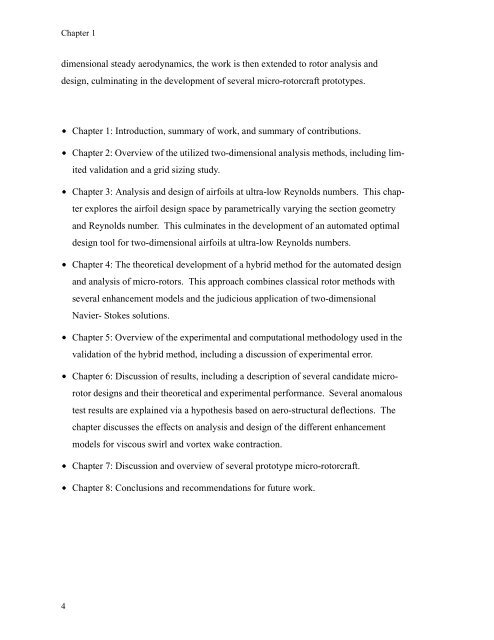Aerodynamics and Design for Ultra-Low Reynolds Number Flight
Aerodynamics and Design for Ultra-Low Reynolds Number Flight
Aerodynamics and Design for Ultra-Low Reynolds Number Flight
You also want an ePaper? Increase the reach of your titles
YUMPU automatically turns print PDFs into web optimized ePapers that Google loves.
Chapter 1<br />
dimensional steady aerodynamics, the work is then extended to rotor analysis <strong>and</strong><br />
design, culminating in the development of several micro-rotorcraft prototypes.<br />
• Chapter 1: Introduction, summary of work, <strong>and</strong> summary of contributions.<br />
4<br />
Chapter 2: Overview of the utilized two-dimensional analysis methods, including lim-<br />
ited validation <strong>and</strong> a grid sizing study.<br />
Chapter 3: Analysis <strong>and</strong> design of airfoils at ultra-low <strong>Reynolds</strong> numbers. This chap-<br />
ter explores the airfoil design space by parametrically varying the section geometry<br />
<strong>and</strong> <strong>Reynolds</strong> number. This culminates in the development of an automated optimal<br />
design tool <strong>for</strong> two-dimensional airfoils at ultra-low <strong>Reynolds</strong> numbers.<br />
Chapter 4: The theoretical development of a hybrid method <strong>for</strong> the automated design<br />
<strong>and</strong> analysis of micro-rotors. This approach combines classical rotor methods with<br />
several enhancement models <strong>and</strong> the judicious application of two-dimensional<br />
Navier- Stokes solutions.<br />
Chapter 5: Overview of the experimental <strong>and</strong> computational methodology used in the<br />
validation of the hybrid method, including a discussion of experimental error.<br />
Chapter 6: Discussion of results, including a description of several c<strong>and</strong>idate micro-<br />
rotor designs <strong>and</strong> their theoretical <strong>and</strong> experimental per<strong>for</strong>mance. Several anomalous<br />
test results are explained via a hypothesis based on aero-structural deflections. The<br />
chapter discusses the effects on analysis <strong>and</strong> design of the different enhancement<br />
models <strong>for</strong> viscous swirl <strong>and</strong> vortex wake contraction.<br />
Chapter 7: Discussion <strong>and</strong> overview of several prototype micro-rotorcraft.<br />
Chapter 8: Conclusions <strong>and</strong> recommendations <strong>for</strong> future work.




